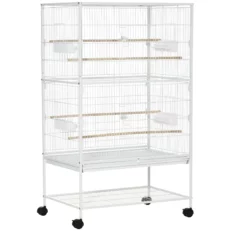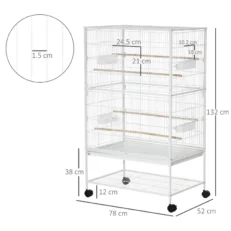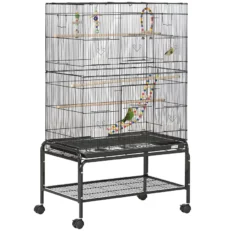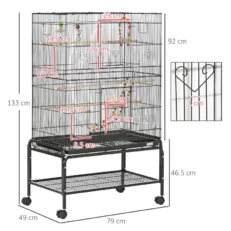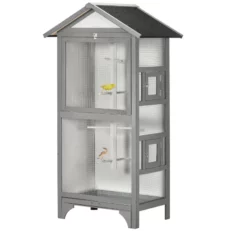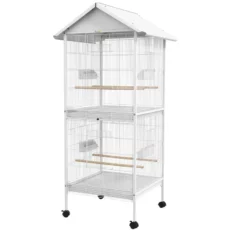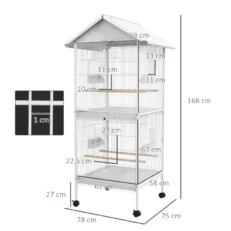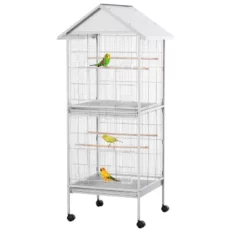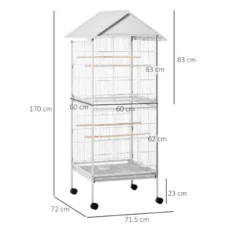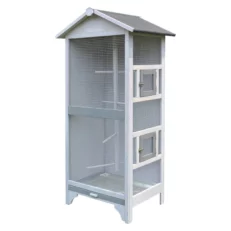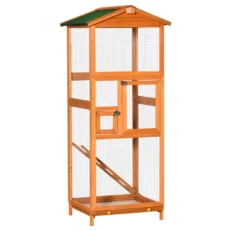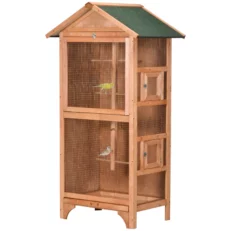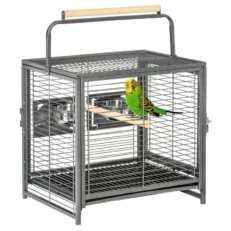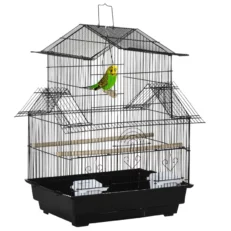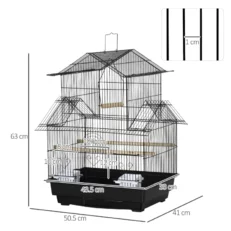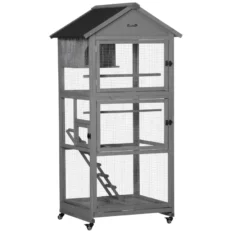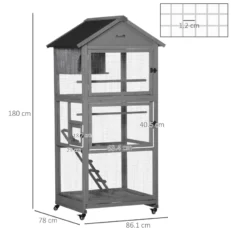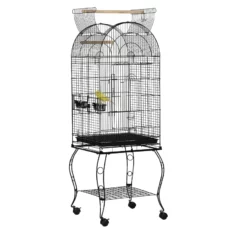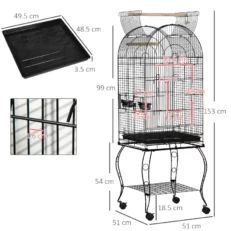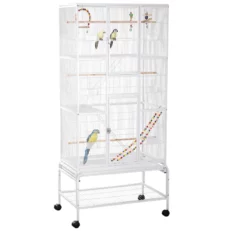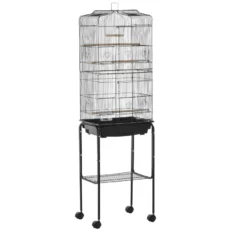
Exploring the sleep patterns of birds unveils a captivating aspect of their behavior, distinct from that of mammals, and is a subject of fascination for both ornithologists and bird enthusiasts. The way birds sleep, characterized by unique features like unihemispheric slow-wave sleep, is an adaptation that allows one half of their brain to remain active while the other rests.
This ability is particularly significant for migratory birds, enabling them to rest during lengthy flights without losing awareness of their surroundings. Additionally, the sleep patterns of birds vary greatly across different species, each tailored to their specific lifestyles and environmental needs. For instance, nocturnal owls and diurnal sparrows exhibit sleep patterns that align with their respective feeding habits, predation risks, and habitat requirements, illustrating the diversity and complexity of avian sleep.
For bird owners, a deep understanding of their pets’ sleep habits is crucial for ensuring their health and well-being. Birds rely on regular sleep patterns for cognitive function, mood regulation, and overall health, much like other animals. The blog aims to enlighten bird owners about the importance of sleep in their avian companions and offers practical advice for creating an optimal sleeping environment. This includes minimizing disturbances, controlling light exposure, and providing a comfortable and secure place for rest, all of which are essential factors in maintaining the health and happiness of pet birds.
The blog is carefully structured to cover various facets of bird sleep in an informative and comprehensive manner. It delves into the physiology of bird sleep, exploring the biological and neurological mechanisms that underlie avian sleep patterns and how these have evolved to meet the demands of different species. A significant portion of the blog is devoted to examining the diversity of sleep patterns across bird species, highlighting how these patterns are influenced by factors such as habitat, diet, and migratory behaviors.
A special focus is given to migratory birds, examining how they manage sleep during their long flights. This section discusses the remarkable adaptations that enable migratory birds to balance the need for rest with the demands of their arduous journeys. Additionally, the blog offers practical advice for bird owners on creating a sleep-friendly environment for their pets. This section is crucial for pet owners as it provides actionable tips and solutions to common sleep-related issues observed in pet birds, ensuring they get the rest they need.
The Science of Avian Sleep
The science of avian sleep reveals a remarkable contrast to mammalian sleep patterns, underscoring the diverse evolutionary adaptations across species. Birds exhibit unique sleep cycles that are fundamentally different from those of mammals, offering an intriguing glimpse into the adaptive strategies of different life forms.
A striking feature of avian sleep is unihemispheric slow-wave sleep, where birds can rest one hemisphere of their brain while keeping the other half alert. This remarkable ability allows birds to remain vigilant to potential threats even in a state of rest, showcasing a sophisticated evolutionary adaptation for survival. The exploration of unihemispheric sleep provides insights into how birds balance the need for rest with the constant vigilance required in their environments.
Birds exhibit a wide range of sleep durations and depths, varying significantly among different species. This variation is closely linked to their lifestyle and environmental needs. Furthermore, birds experience Rapid Eye Movement (REM) sleep, albeit in a much more condensed and less frequent form than mammals. This section of the blog will delve into the implications of these sleep patterns for avian dream processes and brain activity, offering a window into the cognitive world of birds.
Bird sleep is also characterized by unique physiological aspects, from their sleeping postures, which often involve tucking their beak under a wing or standing on one leg, to their choice of sleep locations, ranging from nests to floating on water for some aquatic species. These postures and locations are not just arbitrary but are intricately linked to their survival strategies, such as conserving body heat and maintaining balance. Additionally, the phenomenon of eye closure in birds during sleep, which varies from complete to partial closure, plays a crucial role in their sleep quality and safety.
The role of light in regulating bird sleep patterns is another fascinating area of study. Birds, much like other creatures, possess circadian rhythms influenced by the cycle of light and darkness, dictating their sleep-wake patterns. The impact of seasonal changes, particularly in regions with extreme variations in daylight hours, on the sleep patterns of birds is significant. For pet birds, the influence of artificial lighting on their natural sleep cycles is a crucial consideration for owners. This section will offer insights into how light affects avian circadian rhythms and provide practical tips for mimicking natural light patterns to ensure healthy sleep for domestic birds.
This comprehensive exploration into the world of avian sleep science not only deepens our understanding of these creatures but also guides better care practices for birds in domestic settings. By examining the physiological, behavioral, and environmental aspects of bird sleep, readers will gain a richer appreciation of the complexity and diversity inherent in the sleep patterns of these fascinating animals.
Deciphering Nighttime Tweets and Sounds
The nocturnal vocalizations of birds offer a window into their unseen nightly activities, revealing a spectrum of sounds that carry various meanings and purposes. Understanding these vocalizations is not only intriguing for bird enthusiasts but also essential for those who care for birds.
Some bird species are known for their enchanting songs during the night, such as the nightingales, whose melodious tunes fill the darkness. These songs serve multiple purposes, including attracting mates and marking territory. The complexity and beauty of these songs demonstrate the richness of avian communication, even in the absence of daylight.
Alarm calls are typically quick and sharp, signaling alertness to potential threats. Recognizing these sounds is crucial in understanding if a bird is feeling threatened or disturbed in its environment. In contrast, contact calls, often soft and repetitive, are used by birds to maintain connection with their flock or partners through the night. These sounds are particularly important in ensuring the cohesion and safety of the group in darkness.
Juvenile birds make distinct noises, especially when communicating with their parents. These sounds can vary from hunger calls to signals of distress or need for attention. Recognizing and interpreting these juvenile sounds can be vital for understanding the dynamics of bird families and the care of young birds.
Differentiating between normal communication and signs of distress is crucial in avian care. Continuous, loud, or unusual sounds at night might indicate that a bird is in distress or experiencing discomfort. A sudden change in the regular pattern of vocalization can also be a sign of stress or illness. Physical signs, such as ruffled feathers or changes in posture, coupled with vocal signals, further indicate a bird’s state of well-being.
The chapter will include real-life examples and anecdotes to illustrate these vocalizations and their interpretations. Stories from pet bird owners about interpreting their pets’ nighttime sounds, observations of wild birds’ nocturnal calls, and insights from ornithologists or avian veterinarians will provide a practical perspective on understanding these sounds.
Through this exploration, readers will gain an enriched understanding of the variety and significance of nighttime bird vocalizations. This knowledge will not only enhance the appreciation of these creatures but also assist bird owners in better understanding and responding to the needs of their feathered companions, whether in a domestic setting or in appreciating the natural behaviors of wild birds.
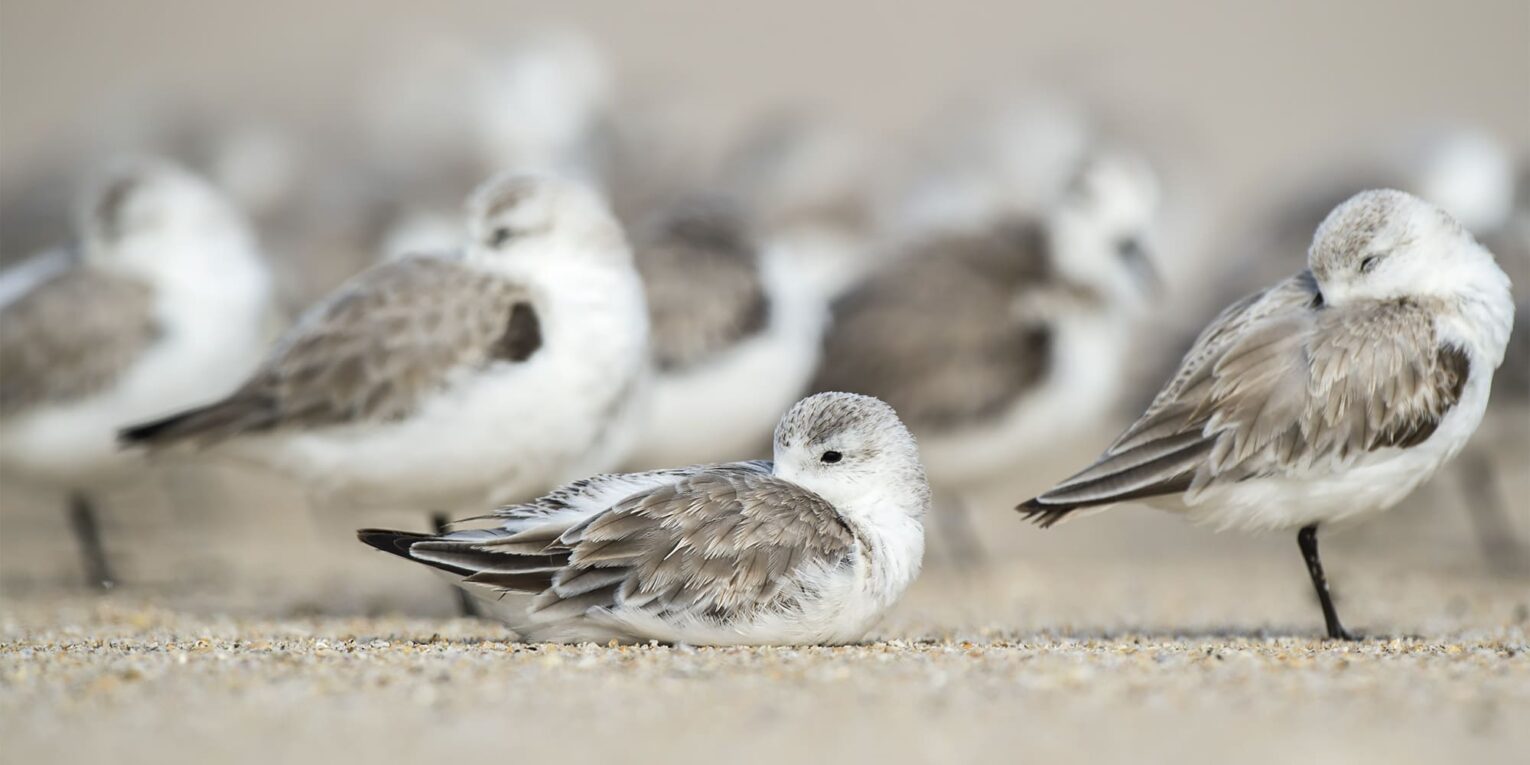
Common Sleep Issues in Birds
Birds, much like humans, can experience a range of sleep disorders that significantly impact their health and well-being. These issues, often overlooked, can have profound effects on their overall quality of life. This section of the blog delves into the common sleep-related problems in birds, exploring their causes, symptoms, and potential solutions.
Insomnia is a notable issue in birds, stemming from various factors like stress, environmental changes, or illness. The symptoms of insomnia in birds can be subtle, ranging from changes in behavior to a noticeable decrease in energy levels. Addressing the root causes of insomnia, whether it’s adjusting the bird’s environment or consulting a veterinarian for health-related issues, is crucial for the bird’s well-being.
Night frights are particularly common in pet birds. These episodes can cause birds to thrash around in their bird cages, which may lead to injuries. Understanding what triggers these night frights — be it sudden noises, shadows, or even changes within the bird cage — is key to preventing them. Strategies to create a safer and more secure sleeping environment will be explored to mitigate these frightful experiences.
Restlessness in birds during sleep is another issue that bird owners might encounter. Signs of restlessness include frequent shifting, fluttering wings, or even vocalizations. Pinpointing the causes, which could range from environmental discomfort to underlying health issues, is essential in addressing this problem.
The sleeping environment is a critical factor in the quality of sleep a bird gets. The placement of the bird’s cage in the home, for instance, can either promote a restful night or lead to disturbances. Factors like lighting, noise levels, and air flow are all influential. This part of the blog will provide tips on optimizing these environmental factors to ensure a peaceful sleep for pet birds.
Physical ailments, dietary factors, and mental health issues like stress and anxiety can all disrupt a bird’s sleep. Illnesses may cause discomfort or pain, leading to sleep disturbances. Nutrition, often an overlooked aspect, plays a significant role in a bird’s sleep quality. Adjustments in diet, coupled with creating a calming environment, can aid in alleviating sleep issues linked to stress and anxiety.
By understanding and addressing these various aspects, bird owners can better care for their feathered companions. This comprehensive guide aims to not only highlight the importance of recognizing and treating sleep disorders in birds but also to provide practical solutions and advice for ensuring the health and comfort of these sensitive and intelligent creatures.
Creating a Sleep-Friendly Environment for Birds
Creating a sleep-friendly environment for birds is essential to their health and well-being. Birds, sensitive to their surroundings, require a carefully arranged habitat to ensure restful sleep, which is crucial for their overall health. This section of the blog offers practical tips on optimizing a bird’s cage and surrounding environment to promote better sleep.
The cage is the primary living space for pet birds, and its setup plays a significant role in their sleep quality. A spacious bird cage positioned in a quiet, low-traffic area of the home is ideal. It’s important to keep the cage away from direct sunlight, drafts, and excessive noise, which can disturb a bird’s sleep. Inside the cage, a variety of perches with different textures and diameters should be provided, allowing the bird to find the most comfortable sleeping position. Covering the cage at night can also create a sense of security and darkness, helping the bird to settle down more easily. Additionally, ensuring the cage is cozy and safe, free from hazards that might disturb or injure the bird during the night, is crucial.
Lighting and noise levels significantly impact a bird’s sleep. Mimicking natural light patterns helps regulate the bird’s circadian rhythm, and this can be achieved using dimmers or timers, and by avoiding harsh artificial lights. Controlling noise levels is equally important; the cage should be placed away from televisions, busy streets, and other sources of loud or sudden noise. In some cases, using white noise machines can help drown out disruptive sounds. Consistency in the light and sound environment is key to maintaining a regular sleep-wake cycle for the bird.
Birds thrive on routine, and establishing a consistent daily schedule is vital for promoting healthy sleep patterns. Aligning the bird’s feeding times with sunrise and sunset reinforces their natural circadian rhythms. Similarly, a consistent bedtime routine helps set the bird’s internal clock. Daytime interaction and activity are important to ensure the bird is sufficiently stimulated during the day and ready to rest at night. Regularly monitoring the bird’s sleep patterns is also recommended, as changes might indicate health issues or environmental stressors.
By adhering to these guidelines, bird owners can provide a nurturing environment that supports their pet’s natural sleeping instincts and physiological needs. This not only ensures the bird remains healthy and happy but also strengthens the bond between the pet and its owner, as a well-rested bird is more likely to be sociable and engaging during its waking hours.
Monitoring and Adapting to Changes in Bird Sleep Patterns
Monitoring and adapting to changes in bird sleep patterns is a vital aspect of ensuring their health and well-being. Birds, like any other pets, can experience changes in their sleep due to various reasons, and understanding how to observe and adapt to these changes is crucial for bird owners.
Keeping a close eye on a bird’s sleep patterns can reveal a lot about its health and well-being. Bird owners are encouraged to keep a sleep diary, logging details such as sleep times, duration, and any disturbances. This record-keeping can be instrumental in noticing patterns or changes over time. Additionally, it’s important to observe behavioral changes like increased lethargy, changes in vocalization, or altered eating habits, as these can indicate disrupted sleep. Physical signs are also telling; ruffled feathers, changes in posture, or signs of fatigue can all suggest sleep disturbances.
Birds’ sleep requirements can change as they age, and health issues can also impact their sleep patterns. Owners need to be aware of these age-related changes, such as the need for more sleep or changes in sleep patterns, and adapt the bird’s environment and routine accordingly. Health issues like arthritis, respiratory problems, or hormonal imbalances can also affect a bird’s sleep. In such cases, making dietary adjustments or modifying the bird’s environment can help in ensuring better sleep quality.
It’s crucial for bird owners to recognize when sleep issues might require professional intervention. Chronic sleep disorders, persistent insomnia, frequent night frights, or prolonged lethargy are signs that a bird might be suffering from a more serious issue and warrant a visit to an avian veterinarian. Behavioral changes linked to sleep disturbances and physical symptoms like unexplained weight loss or changes in breathing patterns during sleep are also indicators that professional help is needed. An avian veterinarian can offer specialized care and advice tailored to the individual bird’s needs.
This chapter aims to empower bird owners with the knowledge and tools to effectively monitor and respond to their birds’ sleep patterns. By understanding how to observe, adapt, and seek help when necessary, owners can provide proactive and responsive care, ensuring the long-term health and happiness of their feathered companions.
Conclusion
In this comprehensive guide, we have embarked on an enlightening journey through the world of bird sleep patterns, offering a treasure trove of insights for both avid bird enthusiasts and caring pet owners. The guide begins by introducing the unique aspects of avian sleep, underscoring its distinct characteristics compared to mammalian sleep and emphasizing its significance for bird owners. This foundational understanding sets the stage for a deeper exploration into the science of avian sleep, where we delve into the intricacies of avian and mammalian sleep cycles, the physiological aspects of bird sleep, and the critical role of light and darkness in regulating these patterns.
The guide then transitions into an intriguing exploration of the nocturnal vocalizations of birds. It uncovers the mysteries behind their nighttime tweets and sounds, distinguishing between normal communication and signs of distress. This section is enriched with real-life case studies and anecdotes, providing practical insights into understanding these vocalizations. Furthermore, the guide addresses common sleep issues in birds, exploring various sleep disorders, environmental factors affecting sleep, and health-related disturbances. This section is particularly beneficial for pet owners, offering guidance on identifying and addressing sleep-related problems in their feathered companions.
In our quest to foster optimal conditions for bird sleep, the guide offers valuable advice on creating a sleep-friendly environment. It provides practical tips on optimizing the bird’s cage, managing lighting and noise, and the importance of establishing a routine to promote healthy sleep patterns. This advice is crucial for pet owners seeking to ensure the well-being and comfort of their birds. Additionally, the guide emphasizes the importance of monitoring and adapting to changes in bird sleep patterns. It offers techniques for observing sleep behaviors, adapting to age and health changes, and understanding when to seek veterinary help. This section is pivotal in equipping bird owners with the skills to provide responsive and proactive care.
To extend the learning journey, the guide suggests additional resources for those interested in deepening their understanding of bird sleep patterns. It recommends scientific studies, expert bird care guides, online bird owner forums, and ornithology books, such as Jennifer Ackerman’s “The Genius of Birds.” This curated list of resources serves as a gateway for further exploration into the fascinating world of avian behavior. Finally, the guide invites readers to engage actively by sharing their experiences and questions about their birds’ sleep patterns. Whether through anecdotes, success stories, or inquiries, this interactive approach aims to enrich the collective knowledge and foster a community dedicated to the well-being and appreciation of these remarkable creatures.
Feathered Kingdom
Feathered Haven
Canary Cottage
Whistle Woodland
FAQs
How much sleep do birds generally need?
- Answer: Most pet birds need about 10-12 hours of sleep each night. This can vary slightly depending on the species.
Why is sleep important for birds?
- Answer: Sleep is crucial for a bird’s overall health, including its immune system, mood, and cognitive functions. It helps in the healing process and maintains a healthy metabolism.
Can a bird’s sleep patterns change with the seasons?
- Answer: Yes, birds can be sensitive to seasonal changes in daylight, which may affect their sleep patterns. Some birds sleep more in the winter due to longer nights.
How can I tell if my bird is not getting enough sleep?
- Answer: Signs of sleep deprivation in birds include irritability, lethargy, and changes in behavior. A sleep-deprived bird might also be more prone to health issues.
Should I cover my bird’s cage at night?
- Answer: Many bird owners find that covering the cage helps create a dark, quiet environment conducive to sleep. However, some birds may not like it. Observe your bird’s reaction.
Do birds experience sleep disturbances?
- Answer: Yes, birds can experience sleep disturbances due to noise, light, changes in the environment, or health issues. Consistency in their environment helps promote better sleep.
Can birds have sleep disorders?
- Answer: Birds can suffer from sleep disorders, though it’s less common than in humans. If your bird shows consistent trouble sleeping, consult a veterinarian.
What’s the best environment for a bird to sleep in?
- Answer: A quiet, dark, and comfortable environment is ideal. The sleeping area should be away from loud noises, bright lights, and disturbances.
Is it normal for birds to take naps during the day?
- Answer: Yes, it’s normal for birds to nap, especially if they are young or are very active during the day. Daytime napping only becomes a concern if it seems excessive or out of the ordinary.
How do I adjust my bird’s sleep schedule to match my lifestyle?
- Answer: Gradually adjust the light and environment to shift your bird’s sleep cycle. However, be mindful not to drastically reduce their overall sleep time.

